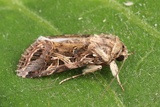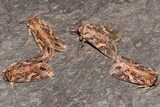Spodoptera littoralis (Boisduval, 1833) Species
Last modified: Feb. 27, 2024, 12:08 p.m.
From origin a native species from Africa and Israel and widely found in both Africa and the Mediterranean Europe. It is a pest species on vegetables, fruits, flowers and other crops.
First observation in Belgium was in WV on 19 September 2018, the following days a total of 4 individuals were trapped. Wether this species came to Belgium with imported crops or supplied by the southern wind
that was present during that period (more southern species were then observed) remains unclear.
Details
- Classification
- Family: Noctuidae > Subfamily: Xyleninae > Tribus: Prodeniini > Genus: Spodoptera > Species: Spodoptera littoralis
- Vernacular names
- Katoenuil (NL), Mediterranean Brocade, African Cotton Leafworm, Egyptian Cotton Leafworm (EN), La Spodoptère littorale (FR), Baumwolleule (DE)
- Status
-
Migrant
For your information, to the best of our knowledge, the first Belgian observations are listed here:
1) 1 ex. on 17.ix.2018 (light trap) at Hooglede (WV), leg. W. Declercq.
2) 2 ex. on 19.ix.2018 (light trap) at Hooglede (WV), leg. W. Declercq.
3) 1 ex. on 20.ix.2018 (light trap) at Hooglede (WV), leg. W. Declercq.
4) 1 ex. on 19.i.2023 (indoors) at Cominnes (HA), leg. B. Duncan.
Distribution
Egg
Eggs are whitish-yellow and are laid in clusters on the lower surfaces of young leaves. They are covered with hair scales from the female’s abdomen.
Caterpillar
Six larval instars occur and larvae grow to 40-45 mm. Young larvae are hairless and blackish-grey to dark green, when they grow they become reddish-brown or whitish-yellow. Final instar caterpillars have dark and light longitudinal bands on sides of the body and dark spots on segments of the dorsal side.
Bionomics
Recently hatched larvae starts feeding on the underside of leaves, but as they grow they move towards the upper surface of leaves resulting in leaf skeletonization or leading to complete stripping of the plants. Larvae may also feed on fruits, pods, and stems of plants. They pupate just below the surface of the soil in a clay cocoon and hibernates. Fresh pupae are green with a reddish abdomen but they turn dark reddish-brown when older. Adults are strongly attracted to light.
Flight periods
It can be seen in every month of the year and has multiple generations.
Observed on
- Substrates:
- Polyphagous and Cultivated crops
It is a pest on vegetables, fruits, flowers and other crops. It has a very wide host range; it feed on over 40 plant families, containing at least 87 species of economic importance. Among their host are: okra, onion, pigweed, peanut, cabbage, cauliflower, pepper, citrus, taro, tea, cucurbits, carrot, fig, geranium, soybean, cotton, sunflower, tomato, lettuce, apple, alfalfa, tobacco, avocado, pine, pea, poplar, plum, pear, oak, potato, eggplant, spinach, clover, wheat, roses, corn etc...



